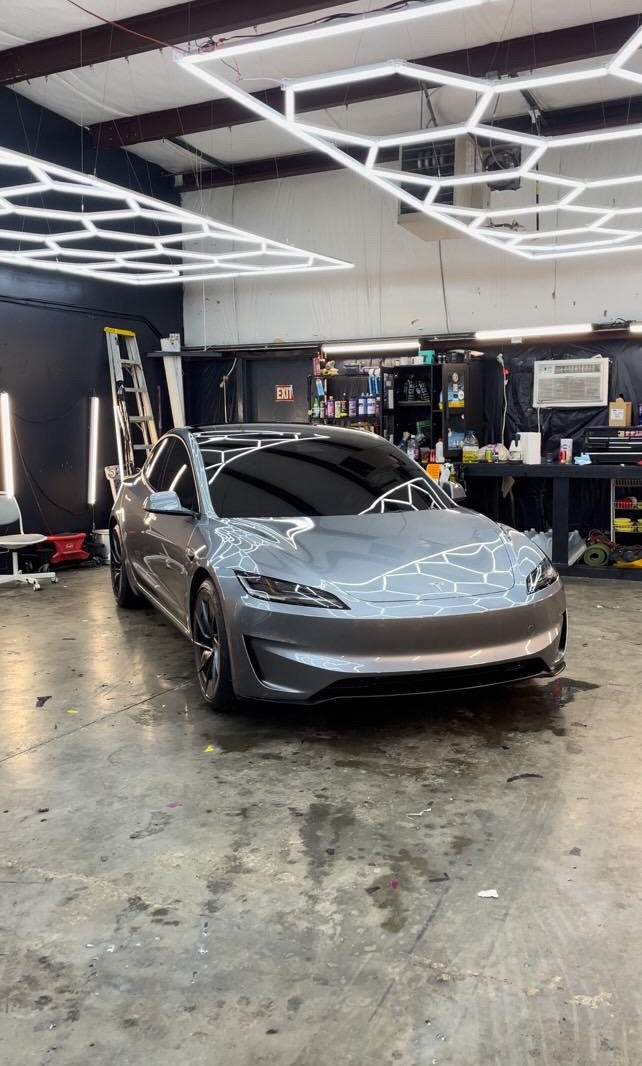Paint correction is one of those detailing terms that often gets thrown around a lot—but let’s be honest, unless you’re a total gearhead, you might not really know what it involves. More importantly, how do you decide between single-stage and multi-stage paint correction? That’s where we come in. Whether your car has light swirl marks or severe oxidation, this guide breaks it all down. Infinite Auto Works is here to help you understand the differences, so you can make the best choice for your car’s finish.
What is Paint Correction?
Think of paint correction as a facelift for your car’s exterior. Over time, your car’s paint suffers from swirl marks, scratches, water spots, oxidation, and even UV fading. These imperfections build up, making even newer cars look tired and dull. Paint correction is the process of removing those surface defects and restoring your paint’s original clarity, depth, and gloss.
This isn’t a simple wax job. It involves machine polishing using specialized compounds and pads to literally level the paint’s surface—cutting away the damaged layer to reveal a fresh, flawless one underneath. The end result? A finish that looks cleaner, smoother, and just plain newer.

Understanding Single-Stage Paint Correction
What is Single-Stage Correction?
Single-stage paint correction is like a “one-and-done” approach. It involves using a polish that combines both cutting and finishing capabilities in a single step. The detailer goes over your car once with a machine polisher using a compound that cuts and refines simultaneously.
This method is perfect for vehicles that have minor swirl marks, light oxidation, or light wash marring. It’s a time-efficient option that delivers noticeable improvements in gloss and clarity without going overboard.
Who is it for?
Single-stage correction is ideal for:
- Daily drivers that just need a refresh
- Cars with softer paint
- Owners looking for a budget-friendly enhancement
- Vehicles being prepped for ceramic coating
While it doesn’t achieve perfection, it dramatically improves your paint’s overall appearance and reflects 60–80% correction in most cases.
Breaking Down Multi-Stage Paint Correction
What is Multi-Stage Correction?
Multi-stage paint correction is a more intensive, multi-step process. It typically involves two or more polishing stages: a cutting stage and one or more finishing stages. The cutting stage aggressively removes deeper defects, while the polishing stages refine the surface, enhancing gloss and clarity.
This method delivers the highest level of defect removal and finish quality. It’s the go-to option when you’re aiming for near-perfection or preparing a show car.
Who Should Go Multi-Stage?
Multi-stage correction is best for:
- Black or dark-colored vehicles that show everything
- Heavily scratched, swirled, or neglected paint
- Show cars or collector vehicles
- Car enthusiasts chasing perfection
It takes more time, effort, and cost—but the results are jaw-dropping. You’ll see an almost glass-like finish that turns heads everywhere you go.
Key Differences Between Single-Stage and Multi-Stage Paint Correction
Here’s a quick side-by-side to make the differences crystal clear:
| Feature | Single-Stage | Multi-Stage |
| Number of Steps | One | Two or more |
| Correction Level | 60–80% | Up to 95–100% |
| Time Required | Shorter | Longer |
| Cost | More affordable | More expensive |
| Finish Quality | Great | Exceptional |
| Ideal For | Light defects | Severe defects |
The best option for your car depends on how far you want to go in restoring that factory-fresh look.
When to Choose Single-Stage Paint Correction
Single-stage correction makes sense when you want an upgrade without going overboard. If your car has minimal imperfections and you’re not chasing perfection, this approach gives you amazing results in less time.
It’s especially useful if you’re planning to apply a ceramic coating afterward. You want the surface to be clean and glossy—but don’t necessarily need it to be flawless.
Another factor? Budget. If you’re looking for a value-packed paint enhancement, this is it.
When Multi-Stage Correction Is Worth It
There’s no sugarcoating it—multi-stage correction is a serious investment. But it’s worth every penny if your vehicle has:
- Deep scratches
- Heavy swirl marks
- Oxidized or neglected paint
- Soft or dark paint that easily shows flaws
This is also the top choice if your vehicle is going to car shows, if you’re wrapping it in PPF, or if you just want the absolute best finish possible. At Infinite Auto Works, we recommend this level when paint perfection is the goal.

Tools and Techniques Used in Each Stage
Single-Stage Tools
- Dual-action polisher
- One-step polish compound
- Polishing pad (medium cut/finish combo)
- Microfiber towels for wipe-down
Multi-Stage Tools
- Rotary or dual-action polishers
- Separate cutting and finishing compounds
- Multiple pad types (cutting, polishing, finishing)
- Paint thickness gauge for monitoring clear coat levels
The approach is also different. In a single-stage, detailers work faster and in larger sections. In multi-stage, they move slower and may revisit problem areas multiple times.
Time Commitment: What to Expect
Time is another major difference. A single-stage correction usually takes 4–6 hours depending on the vehicle’s size and condition. On the other hand, a full multi-stage correction can easily stretch to 10–20+ hours over multiple days.
That’s because each panel is worked on with care, and multiple passes are made with different compounds to perfect the finish.
Cost Comparison Between Single and Multi-Stage
Cost varies by vehicle, paint condition, and location, but here’s a ballpark breakdown:
- Single-stage paint correction: $250–$600
- Multi-stage paint correction: $600–$1,500+
At Infinite Auto Works, we offer both options depending on your needs. While multi-stage is more expensive, it provides a finish that lasts longer and looks showroom-ready.
How to Tell Which Option Your Car Needs
Still unsure which route to take? Here are a few tell-tale signs your car may need multi-stage over single-stage:
- You can feel scratches with your fingernail
- Swirl marks are visible even in low light
- Paint has heavy oxidation or a chalky texture
- You want a near-perfect finish for a show or event
If these don’t apply and your paint is just dull or lightly swirled, single-stage might be more than enough.
The Role of Paint Type and Condition
Your paint type matters more than you might think. Softer paints (like those on many Japanese cars) are easier to correct, even in a single stage. Harder paints (like on German vehicles) usually require more correction time—and often, multiple stages.
Also, previous detailing work, age of the vehicle, and thickness of the clear coat all play a role in what’s possible.
Prepping Your Car for Paint Correction
Before any correction starts, the car must be decontaminated properly. That means:
- Snow foam and hand wash
- Iron and tar removal
- Clay bar treatment
Skipping this step can lead to pad contamination and swirls. At Infinite Auto Works, our prep process is just as important as the correction itself.
Why Paint Correction Should Be Done by Professionals
This isn’t the time for a DIY experiment. Improper machine polishing can lead to:
- Burned clear coat
- Uneven finishes
- Holograms or buffer trails
Trust professionals like Infinite Auto Works—they have the tools, lighting, and experience to get the job done safely and correctly.

How Paint Correction Sets the Stage for Protection
After correction, your car’s surface is ready for a sealant, wax, or ceramic coating. Correction not only enhances the look but also ensures that protective products bond better to the surface.
Applying ceramic coating on uncorrected paint is like sealing in flaws. Correct first, protect after.
Conclusion: Which Should You Choose?
Here’s the deal—there’s no universal right answer. It all depends on your goals, paint condition, and budget. If you just want your car to look better than it did yesterday, go for single-stage. If you’re chasing that “better than showroom” shine and want to erase years of damage, multi-stage is the way to go.
At Infinite Auto Works, our Paint Correction service is built on transparency and helping car owners make informed decisions. Whether you’re going for subtle enhancement or full-blown perfection, we’ve got your back (and your paint).
FAQs: Single-Stage vs Multi-Stage Paint Correction
Q1: Can I start with single-stage correction and upgrade later?
Absolutely. Single-stage is a great way to improve your car’s appearance, and you can always go multi-stage in the future if deeper correction is needed.
Q2: Is paint correction safe for older vehicles?
Yes, if the clear coat is intact. We always check the paint thickness before beginning correction to ensure it’s safe for polishing.
Q3: Will multi-stage correction remove every scratch?
No. Deep scratches that go beyond the clear coat can’t be completely removed, but multi-stage correction can make them far less noticeable.
Q4: How do I maintain the results after correction?
Avoid drive-through car washes, use high-quality microfiber towels, and wash your car using safe methods. Ceramic coating also helps preserve the finish.
Q5: Is paint correction worth the cost?
Without a doubt. It dramatically improves the look, extends the life of your paint, and increases resale value—especially when done professionally.
